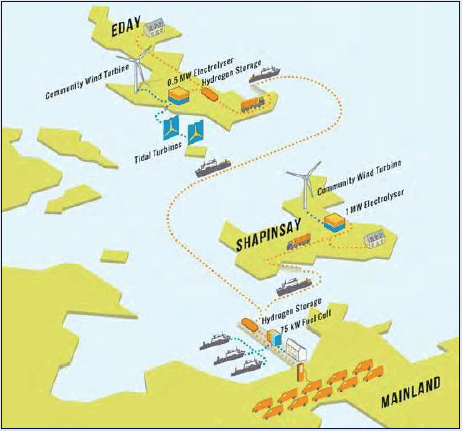

Decarbonisation Whisky Distilleries


Hydrogen
Hydrogen is gaining popularity around the world as a low carbon fuel source. Unlike fossil fuels, there is no carbon dioxide released when hydrogen is burned. The equation for the combustion of hydrogen is:
There are three main types of hydrogen [1]:
-
Grey hydrogen – this is hydrogen produced by fossil fuels and releases carbon dioxide in the manufacturing process.
-
Blue hydrogen – this is hydrogen produced by fossil fuels but carbon capture and storage is used to avoid most of the carbon dioxide emissions
-
Green hydrogen – this is hydrogen produced by electrolysers supplied by renewable electricity
This project is based around green hydrogen as an alternative fuel as it has the lowest carbon footprint. Where the use of hydrogen has been analysed this is from the perspective of green hydrogen.
The use of hydrogen boilers in the Scottish whisky industry is not commonplace at present. Currently there are 8 distilleries that have completed a feasibility study. Only one of these distilleries, Bruichladdich, has been awarded the funding to move to the next stage. In this next stage Bruichladdich are installing a hydrogen boiler and will run for a year.
As there are no distilleries with data on running with hydrogen this tool has been based off assumptions from literature as well as data given from suppliers.



Credit: Ørsted
Why Hydrogen?
Using hydrogen requires a relatively simple installation as it requires a direct boiler replacement, plus any additional storage. This means shorter downtime for distilleries and therefore lower operational losses. It is expected that distilleries that are connected to Scotland’s gas infrastructure could have hydrogen replace the natural gas. Initially it could be a blend of hydrogen and natural gas, with the proportion of hydrogen being increased until it reaches 100% [3]. There are hydrogen boilers designed to run on hydrogen and natural gas blends that would be suitable for use in this transition period.
Scotland has plans to become a leading hydrogen nation. There is £100 million of funding available to the hydrogen section over the next five years [4]. The target is to reach 5GW of renewable and low carbon hydrogen by 2030. Scotland is in a strong position to be a leader in hydrogen due to its availability of renewable resources, for example having 25% of Europe’s offshore wind resource [3].
The hydrogen network in Scotland is currently being expanded and the Scottish Government is aware of the importance of including rural and island communities in the hydrogen network. This means that in the future areas that were previously restricted, for example through constrained electricity or gas grids will be able to access hydrogen as a fuel source [3]. This could make hydrogen a more appealing fuel source to distilleries in more rural or hard to access areas.
[3]
With green hydrogen being produced from renewable sources, this means that islands and rural locations are often in ideal locations to generate hydrogen from sources such as tidal and wind. This can make hydrogen fuel even more accessible to harder to access distilleries as they become the point of generation. One example is the Building Innovative Green Hydrogen Island Territories project (above), which was launched in 2018 with the aim of growing a hydrogen economy for Orkney [3].


Carbon Emissions
Green hydrogen releases no carbon during combustion so could be argued to not have a carbon footprint. However, to avoid greenwashing a value has been taken of the worst-case generation of hydrogen. This accounts for methane released from the reservoirs of hydro generation. Therefore, the carbon value has been taken as 0.6 kgCO2e/kgH2 [5].
It is assumed that the transport of hydrogen has no footprint because many hydrogen companies run on net zero transport.

Problems with Hydrogen
Green hydrogen is currently relatively expensive. It is more expensive than blue hydrogen which is currently about half the price [3]. This is because the feedstock for green hydrogen is renewable energy. The electricity price of the UK will impact the cost of hydrogen as this will prioritise where renewable energy is used [3]. Therefore, as with electrification, these estimates are likely to be impacted by the current energy crisis.
Affordable green hydrogen will be influenced by the markets. An established market demand with demand also coming from outside of Scotland will encourage more investment and ensure that green hydrogen is affordable sooner [3]. If this market demand does not come, then the cost of hydrogen will stay high and not be affordable for distilleries.
Hydrogen has a lower energy density than natural gas and this creates challenges with storage. If natural gas were replaced with hydrogen, then the storage infrastructure would need to increase 3-4 times [6]. This will require more capital investment and also requires distilleries to have the space required for the extra storage.

Calculations

1) Calculate heating demand if not given.
Operational Costs
2) Allow for boiler efficiencies and divide by the lower heating value of hydrogen (33.3kWh/kg)
3)Multiply by predicted hydrogen costs for each year
Capital Costs
4) Calculate boiler rating if not given
5) Calculate cost of boiler from supplier data.
Working with supplier to take typical costs of hydrogen boilers (including installation) for various boiler ratings we deduced the following equation [7]:
6) Calculate amount of storage required
7) Use feasibility studies to cost storage [2]
Assuming pressurised gas storage data was taken from feasibility studies to deduce the following equation to calculate the cost required for onsite storage of hydrogen:
8)Add boiler and storage cost to get total capital cost




References
[1] Noussan, M. et al., 2021. The role of green and blue hydrogen in the energy transition—a technological and geopolitical perspective. Sustainability (Basel, Switzerland), 13(1), pp.1–26.
[2] Protium, Deuterium, Bruichladdich and ITPEnergised (2020). Project HyLaddie BEIS Green Distilleries Competition Phase 1 Report. [online] Available at: https://assets.publishing.service.gov.uk/government/uploads/system/uploads/attachment_data/file/978975/HyLaddie_Phase_1_Feasibility_Report.pdf [Accessed 16 May 2022].
[3] www.gov.scot. (2020). 3 A Scottish Hydrogen Economy. [online] Available at: https://www.gov.scot/publications/scottish-hydrogen-assessment-report/ [Accessed 4 Apr. 2022].
[4] www.gov.scot. (2020). Building a new energy sector. [online] Available at: https://www.gov.scot/news/building-a-new-energy-sector/ [Accessed 4 Apr. 2022].
[5] Ewing, M., Israel, B., Jutt, T. and Stepanik, L. (2020). Hydrogen on the path to net-zero emissions Costs and climate benefits. [online] Available at: https://www.pembina.org/reports/hydrogen-climate-primer-2020.pdf. [Accessed 4 Apr. 2022].
[6] Bloomberg. (2020) Hydrogen Economy Outlook Key Messages. [online] Available at: https://data.bloomberglp.com/professional/sites/24/BNEF-Hydrogen-Economy-Outlook-Key-Messages-30-Mar-2020.pdf [Accessed 4 Apr. 2022].
[7] Byers, J (2022) Email to Kaustubh Dhabale, 28 February 2022.